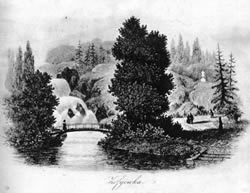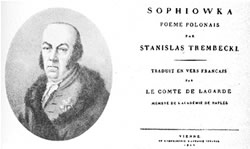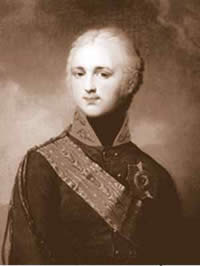| - 5 - |
|
The entrance to the park until 1836 was from the side of a greenhouse. The road was built only in 1833. In her letter of March 16, 1816 to S.Kostka Potocki, Stanislaw's cousin, Sofia wrote that her passed-away husband made the obelisk with the words carved in Greek and Latin “Love presents Sofia”. It was designed to place the obelisk in the yard of "Sofiyivka" in front of the palace, which would be built. Their son Oleksandr wanted to fulfill this plan. De Leggard, who saw the obelisk in 1811, noted that it was 60 feet high, made of one granite block and had a signature "Love presents Sofia". The place is unknown, though.
|
 Sofiyivka of that time,
Sofiyivka of that time,
the picture from the Trembecki’s book |
As it was mentioned, till 1820 there was no hut (little house) on the spot where Flora Pavilion is situated now. The whole sight of Lower pond was opened in front of the visitors. Also, there was no Snake on Great fountain. The water just came out of a hole in a stone. It was supplied through temporary (perhaps wooden) pipes, as cast-iron pipes made at Tula plant were installed only in 1808.On the rock of the eastern bank of the pond (now Caucasian Hill or symbolic Ithaca island) a statue of Cupid was mounted in the octagonal balustrade on the granite pedestal, Pastoral house was built on Leucadian rock.
On the western bank of Lower pond a solid wall of Dubinka's trees was very close to the alley, as there was neither Belle View Terrace nor the alley to Chinese pergola. There were no terraces and the obelisk on the Terrace of Muses. On the granite Hippocrene's spring, decorated with aureate grass snakes, one could see an alabaster vase with flowers.
According to S.Groza's "Description of Sofiyivka", there was Venus temple right on the place where the statue of Paris stands at the assembly square now. On both sides of a stone slab (it is still here) four granite pillars, a bit more than 0.5 m high, were installed with marble vases with flowers on them.
In the Temple valley, not far from the left bank of the stream, a white marble vase was on a granite pedestal, winded round with a garland of roses; according to Groza's statement, it was the temple of Goddess Flora. Near the Athenian school in the pine-tree grove, planted in the form of heart, a granite pedestal was mounted on a granite slab; there a marble vase with the bas-relief picture of God Hymen was placed.
Along the bank of the Kamianka river there is a tetrahedral pedestal of gray granite. During Metzel's time, it was surrounded with Lombardy poplars. There was a vase with flowers on the pedestal; a black marble board, which had the carved octave, was fixed to it. The author of the words addressed a fast-flowing stream, which was saying good-bye to a flourishing bank, and grumbled: "Similarly, every happy day of ever individual passes so fast". It is S.Potocki who is the author of "appeal". Two lines carved in the Calypso grotto belong to him as well.
Above the waterfall and the temple of Thetis (at the edge of the dam) four sea-monsters were installed along the fence; the bust of Paleus was placed in the grotto. Turtledoves were kept in the "Hen House", situated on the right bank of the stream. The bridge did not connect the island of Anti-Circe on the “Sweet” or “Magic” sea; one could get there only by boat; docks were both on the dam and on the island. Recollecting the "Hen House", de Leggard writes that from it one can hear "the twittering of many birds blending with the sounds of the waterfall."
According to S.Groza, the works aimed at improving "Sofiyivka" had not been stopped before L.Metzel's departure to Warsaw. "Every day, - he writes, - almost few dozens of people were engaged in blasting operations and polishing granite, planting trees and improving hydro system." Sofia Potocka "did not grudge money to increase the beauty of "Sofiyivka" A lot of huge rocks, valleys and hills all of these would be semi-dead, if L.Metzel's taste and talent were not used. The nature is always majestic, but if a skilled master's hands touch it, it becomes much more majestic."
Another aspect of L.Metzel's activity in "Sofiyivka" is rather interesting. It is known from his letters, that when the park was being built, on June 16 1799 cauliflower plants were sent from Uman to Tulchyn, in 1800-1803 - melons and their seeds, cherries of a specific variety. In the autumn of 1803 more than 30 thousand of cocoons were sent. No facts remained to prove how long this activity continued after the magnate's death.
In 1813 L.Metzel was appointed head of the department of land and waterways of communication of Polish kingdom, so he left for Warsaw.
After S.Potocki's death, his oldest son Yuri, a gamester and squanderer, became the owner of the estate. He canceled general chynsh (rent) and resumed the old rule. The peasants' duties were increased. In addition to his father's debt which amounted to 7.5 mln Zloty, Yuri lost nearly 30 mln., almost all his estate. In Petersburg he managed to legally transfer to his stepmother Sofia the right to own the part of the estate, which belonged to her and her children. In 1808 Sofia tried to sell Uman and "Sofiyivka" to tsar government. The latter was not willing to buy the entities. On the 10th of September 1810 Sofia addressed Oleksandr I to speed up the process. This transaction did not take place. At that time the park was in a very good shape.
The translation of S.Trembetski's poem "Sofiivka" was done by de Leggard on
Sofia's request (the poem in polish, as
well as the comments of Adam Mickiewicz, can be found here);
|
 The french translation of the Trembecki’s poem with the portrait of the author,
The french translation of the Trembecki’s poem with the portrait of the author,
Wien |
in 1815 it was published in Paris in French and Polish, which helped promote Uman park all over Europe.
In 1820 Oleksandr I (as it was mentioned earlier) visited "Sofiyivka". The following spring Sofia sent a consignment of Lombardy poplar seedlings to Petersburg.
|
 Oleksandr I, the imperator of Russia
Oleksandr I, the imperator of Russia |
In his personal letter of June 30 1821 the tsar thanked Sofia sincerely. Unfortunately, Sofia was leaving this world, being incurably sick. In autumn of 1821 Sofia went to Petersburg, there on May 22 1822 she wrote her will. She has never come back to Uman. Straight from the capital Sofia headed for Berlin where she passed away on November 12 (24) 1822.
Sofia's son Oleksandr (born in 1798) took over the estate. Once he was in the Caucasus and got the title/rank of a colonel. As literary sources stated, living in Warsaw O.Potocki was not interested in the park and neglected it very much. In fact, he visited Warsaw only once, in 1831. He used to live in Tulchin, Odesa, and Uman; and "Sofiyivka" looked very beautiful at that time. During the time of O.Potocki a marble statue of T.Kostiushko (on the Caucasian Hill) and that of general Y.Poniatovski (in the Elysian Fields), a nephew of the last Polish king, were installed in the park. On O.Potocki's request, in 1829 AAndrzhievskiy made a description of the plants grown in the park.
O.Potocki was depressed by the contempt of Polish gentry. In his letter of May 2 (14) 1831 from Berlin, he wrote that he had left Russia not to be compromised, and not to take part in the uprising, that there were so many hotheads in the country and "I do not want to have any connection with them, I am afraid of gallows and execution; because of all this It is better to stay in Vienna or Berlin It is not my fault that I have a Polish last name, very much stained in addition But under the pressure of his older sister Sofia Kysyliova (she married the tsar's favorite) he arrive in Warsaw on the eve of the uprising defeat, he also financed the formation of the regiment, which did not managed to make at least one shot. On the 14th of January 1831 O.Potocki left Kremenets Volynsky district, as he wanted to settle in Galicia; but Polish gentry met him with even bigger hatred and he moved to Vienna.
When in 1831 the tsar's troops occupied Warsaw, it became a known fact in Petersburg that O.Potocki joined Polish uprising. According to the Tsar's decree all the estates of "mutineer" Potocki were sequestrated, but his commissioner managed Oman estate. On the 13th of March 1832 Kyiv treasure appointed the manager - the captain of Guard Markevych by name. It was the first period of the development of "Sofiyivka", which was under the jurisdiction of the Department of military settlements of Russia in 1836-1859.
| |
 |
 | In the history of foundation, construction and development of "Sofiyivka" we distinguish six different periods throughout the years.
- 1796-1831. The Foundation.
- 1831-1859. The Tsarina's garden.
- 1859-1929. The School of Horticulture.
- 1929-1955. The State Reserve.
- 1955-1980. The Academy of Science.
- 1980 till present.
|
|
 |
| The park, as a scientific institution of the National Academy of Science of Ukraine, is engaged in researches of connatural and cultural flora of austral Forest-steppe of Ukraine, introduction and acclimatation of plants in the region. The article of the director of the famous park I. Kosenko summarizes this work: |
| 50 years anniversary of the Sofiyivka park as a scientific institute of the Ukraine's NAS |
|
| In the final article of I. Kosenko the review of the park's whole history from the moment of the foundation till todays is made: |
| 205 years since the foundation of Sofiyivka |
|
| The team of scientists of the park issued the catalogue of plants with the total amount 1994 taxons, in which 25 taxons of hazels, 24 beeches, 41 fir-trees, 44 junipers, 100 lianas, 320 roses, 57 rhododendrons and 98 flower plants - totally 1220 trees and bushes and 774 herbaceous plants.
|
| Catalogue (zip 380 КB) |
|
| The hothouse of the park is the unique center of cultivation of conifers and deciduous trees, bushes, roses seedlings - total more than 200 items. | Price-list
Open|Download (22 КB) |
|
| The beauty of the park was sung by a lot of poets, but the poem of the Polish poet S. Trembecki occupies an especial place. Written in 1811, it is the park guide book in verses.
"Sofiowka" and comments of Adam Mickiewicz (polish) |
| | Park as the tourist center offers the visitors a complex of services - excursion support in six languages, hotel, restaurant, conference hall etc. | | List of services |
|
|